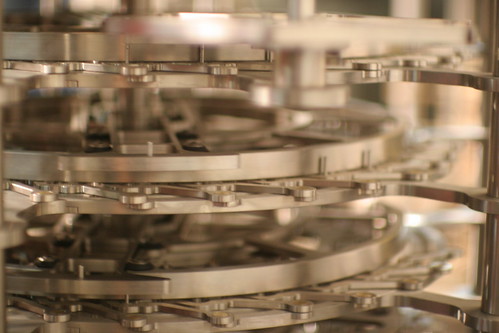I’ve been meaning to post about this for a while, but finally got around to it after reading at Boing Boing that the Long Now project unveiled their prototype, the Orrery clock. Jacob Appelbaum has some great photos of the event.
What is all this fuss over a clock? Discover has a lot of good info about The Long Now project.
While nearly every mechanical clock made in the last millennium consists of a series of propelled gears, this one uses a stack of mechanical binary computers capable of singling out one moment in 3.65 million days. Like other clocks, this one can track seconds, hours, days, and years. Unlike any other clock, this one is being constructed to keep track of leap centuries, the orbits of the six innermost planets in our solar system, even the ultraslow wobbles of Earth’s axis.
Made of stone and steel, it is more sculpture than machine. And, like all fine timepieces, it is outrageously expensive. No one will reveal even an approximate price tag, but a multibillionaire financed its construction, and it seems likely that shallower pockets would not have sufficed.
Still, any description of the clock must begin and end with that ridiculous projected working life, that insane, heroic, incomprehensible span of time during which it is expected to serenely tick.
Ten thousand years.
The span of time from the invention of agriculture to the present. Twice as long as the Great Pyramid of Giza has stood. Four hundred human generations…
I find the whole thing amazing. Thinking about humans in this sort of timeline is really unheard of in our culture. They plan to put the clock into a man made cave near Great Basin National Park in eastern Nevada. The area is dry, remote, stable, and surrounded by bristlecone pines. Rather appropriate, I think.
There are just so many things about this clock that I find great. The clock is mechanical, and thus will not be a black box to an outsider. It uses the solar system to show the time, something that is easily understood to all people. It has solar synchronization: A sunbeam striking a precisely angled lens at noon triggers a reset by heating, expanding, and buckling a captive band of metal. They plan to make the clock charismatic, and easy to interact with – to even require attention from people. There are also plans to include a library of sorts to the project. This will include things like the Rosetta Project (publicly accessible online archive of ALL documented human languages) and the Long Server (pervasive server and email infrastructure, open source Timeline tools, and file format conversion).
The project is massive, and threatens to become a Library of Alexandria for the future. I love it.

I remember listening to an interview with Brian Eno about this project … I wish I could find the link … he kept getting asked how the project has any relevance at all to our everyday lives and was brilliantly articulate about it.
Reminds me of Even Cowgirls Get the Blues by Tom Robbins.